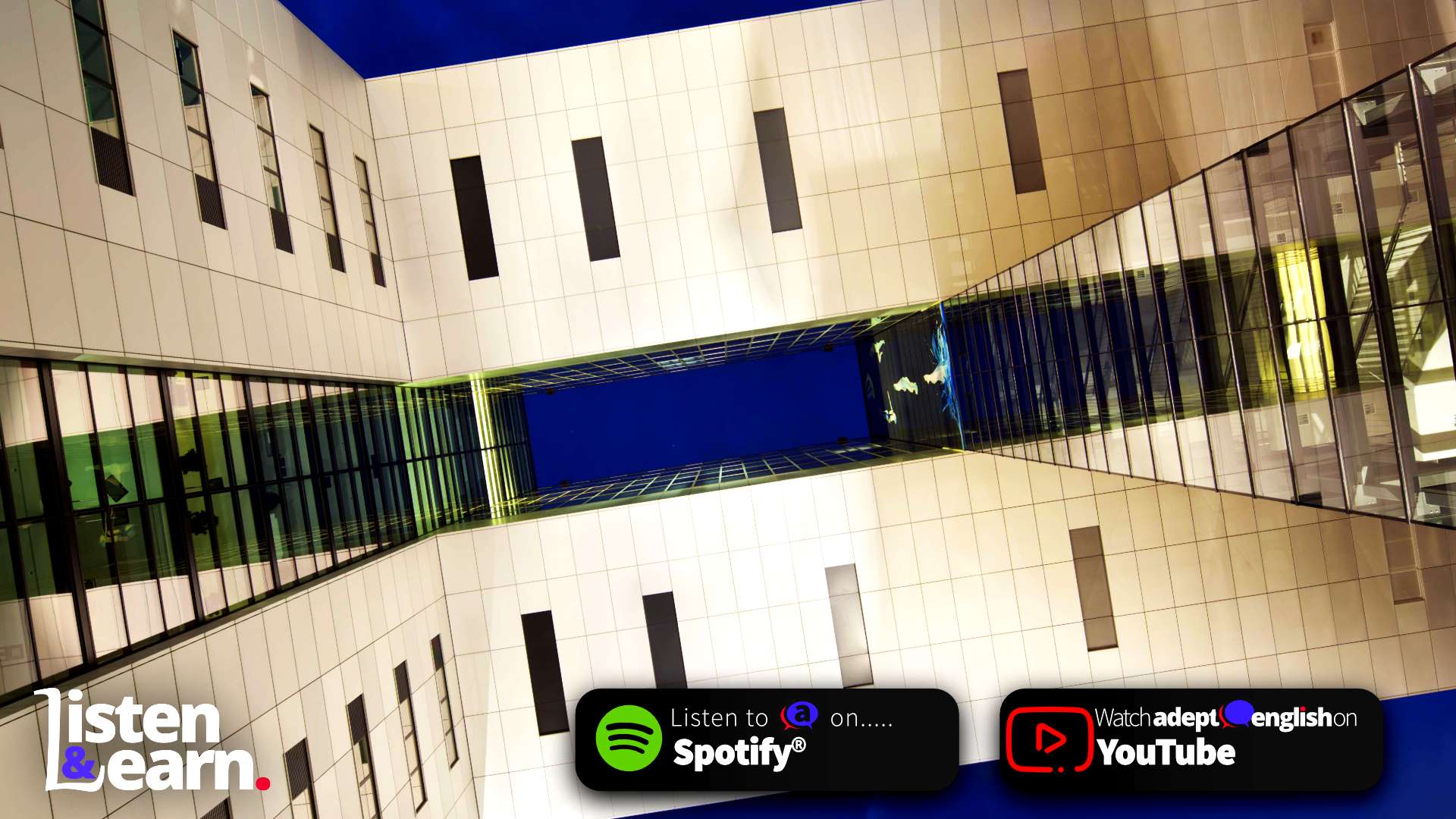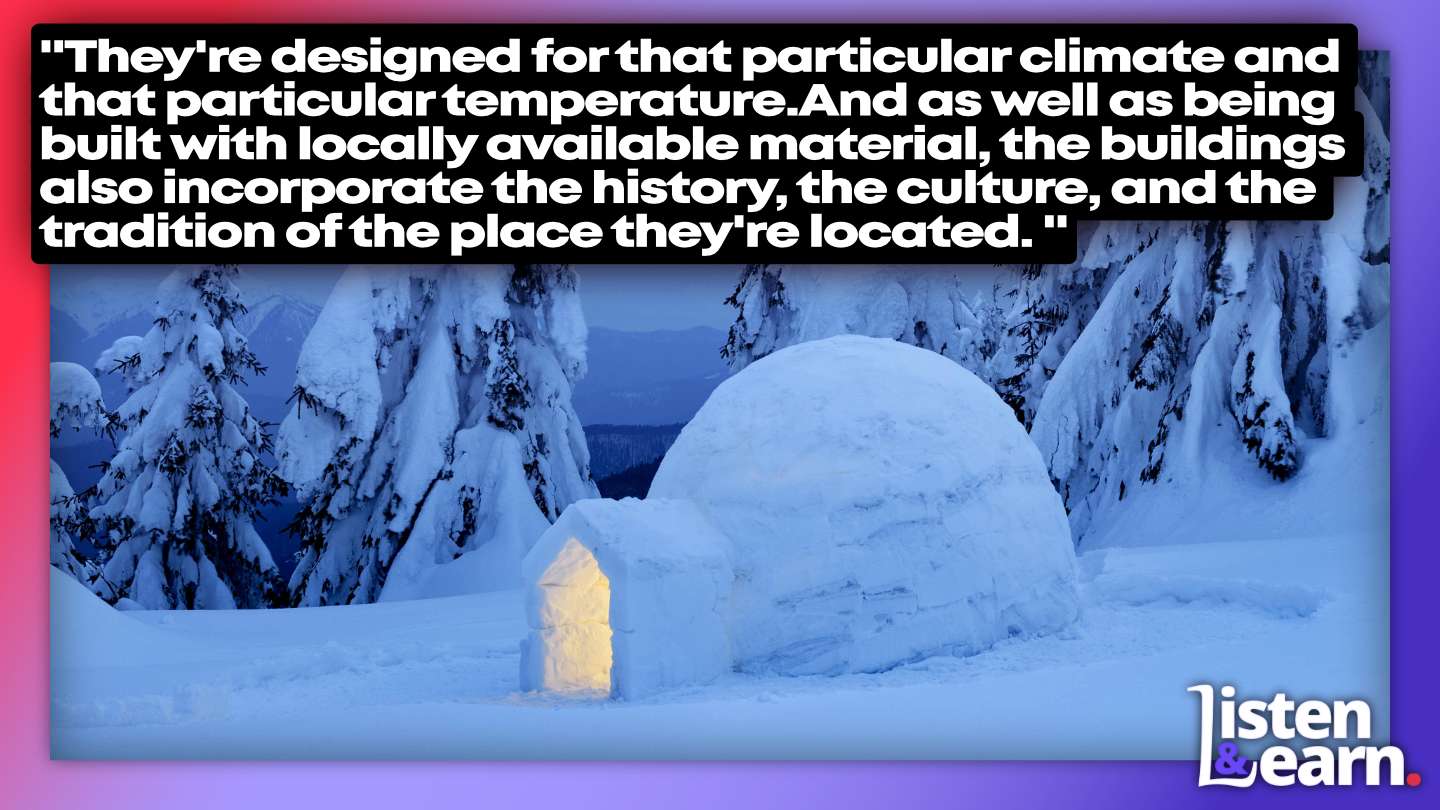How can this podcast help me improve my English fluency?
If you’re an English language learner who wants to take your spoken English fluency to the next level, this is the podcast for you! Today we have an English language learning podcast about architecture–you will learn new English vocabulary, pronunciation, and practical tips to become a more confident English speaker.
Listening to native English speakers will help you gain a better understanding of the English language, along with increasing fluency and comprehension. Don’t miss out! Subscribe and follow the podcast channel and take your English skills to a whole new level!
More About This English Lesson
Learning a new language can be a daunting task, especially with speaking fluently. This English lesson, specifically about architecture, will help English language learners like you improve your spoken English fluency.
✔Lesson transcript
Listening to native English speakers is a great way to improve spoken English. Hearing new vocabulary in context and the correct pronunciation will help you with your own intonation and understanding. The hundreds of thousands of people who listen to us every month find that listening to native English speakers is one of the best methods for language learners to gain a better understanding of the English language, along with increasing fluency and comprehension.
Experience tells us that English language learners may be hesitant to listen to native English speakers, but there are many benefits to this. Not only does it help with intonation and pronunciation, but it also provides the listener with new vocabulary and expressions. Listening to native English speakers can help improve confidence, as hearing the language repeatedly can make it easier to comprehend.
- Help us make more content with a donation https://adeptengli.sh/donate
Making the content you listen to interesting is key to keeping you listening. This English lesson podcast about architecture will take you on a journey to learn new English vocabulary, pronunciation, and practical tips to become a more confident English speaker. The podcast will provide strategies to help listeners overcome any challenges or obstacles in increasing their spoken English fluency.
If you’re an English language learner who wants to increase your spoken English fluency, this podcast is the right choice for you. Subscribe and follow the podcast channel and get ready to take your English skills to a whole new level!
Most Unusual Words:
- Architecture: The art of designing buildings.
- Career: The job or series of jobs you do for a long time in your life.
- Psychotherapist: A person who helps others with their mental health by talking.
- Sustainably: Doing things in a way that doesn't harm the environment.
- Vernacular: The everyday language spoken by people in a certain area.
- Traditional: Following old ways or customs.
- Terraced: A type of house that shares walls with houses on both sides.
- Backlash: A strong negative reaction to something that has happened.
Most common 2 word phrases:
| Phrase | Count |
|---|---|
| The Future | 3 |
| Help You | 2 |
| Working Life | 2 |
Listen To The Audio Lesson Now
The mp3 audio and pdf transcript for this lesson is now part of the Adept English back catalogue . You can still download and listen to this lesson as part of one of our podcast bundles.Transcript: Architecture English-Take Your English Skills To A New Level
Hi there. Today let's talk about something different - architecture. That's A R C H I T E C T U R E. And 'architecture' means 'the design of buildings, of the built environment'.
And buildings are what we live and work in. So they affect all of us. And I want to look today at an interesting idea, something which is likely to influence architecture in the future.
As usual, use this podcast to practise your English, to practise your English understanding. Improving your listening skills is the most important thing, if you want to become fluent in English. And Adept English is here to provide you with just the right sort of material to help you do that.
Hello, I’m Hilary, and you’re listening to Adept English. We will help you to speak English fluently. All you have to do is listen. So start listening now and find out how it works.
Don't forget - you can download 100s of podcast to your phone!
If you would like more listening materials so that you can continue your English language learning, then go to our website at adeptenglish.com and click on our Courses page. Here you can buy hundreds of Adept English podcasts just like this one, for a very small price!
You'll be able to download them to your mobile phone so that you have them with you wherever you are. And that means much more English listening practice, which is going to help your fluency.
Boost Your Learning With Adept English
Why the interest in architecture?
So why was I thinking about architecture particularly?
And what trends are likely to influence architecture in the future?
Well, my son is 14 and at the moment, if you ask him what he wants to study and what industry he might want to work in, he says 'Architecture'. He'd like to be an architect. Now, of course he's 14, so this may change. A couple of years ago it was 'a Marine Biologist' when you asked him, but 'Architecture' is what he says right now.
If my son does become an architect, it would take a long time. He's 14. The training is lengthy. So he's unlikely to achieve that goal of being an architect before he's 25 years old. So I was wondering what might shape his career, what might shape his working life if he chooses this path?
Listening Lessons
Hard to predict where and how you're going to work!
I'm reminded of what used to be said all the time when my daughters were choosing their university options - that the areas that they'll end up working in, in their working lives, we don't even know about them yet. And that's certainly true for me too. When I was choosing my A Levels and my degree subject, I didn't know about Adept English, and I certainly didn't know I was going to be a Psychotherapist.
So the path changes, but it's still interesting to reflect that if you choose a particular career, what is it that you might be dealing with, in your working life?
What are the big considerations for architects of the future?
So what are going to be big considerations for the architects of the future? Obviously the environment and the 'greenness' of buildings. So whether or not they're built 'sustainably', that's S U S T A I N A B L Y. If something's built 'sustainably', it doesn't damage the environment as you build it.
And architects are probably also going to be worried about our climate. Climate change - in whatever direction that goes - will affect the design of buildings.
One of the things that I came across when I was doing a little bit of reading around 'architecture of the future', the notion, the idea of ' vernacular architecture'.
The idea of 'vernacular architecture'
The word 'vernacular' is quite advanced level in English, V E R N A C U L A R, but it's useful here. 'Vernacular' means 'of a certain region'. It means 'non-standard' and 'related to a particular location'. That's 'vernacular' and there's currently a lot of interest in 'vernacular architecture'.
So 'vernacular architecture' means 'buildings whose design is specific to a particular location in the world'. And what's interesting about this, this 'design' in inverted commas, quotation marks, if you like - designs of vernacular buildings, they're not by architects. They've usually evolved over hundreds of years. ' Vernacular architecture' means 'buildings made to old traditions'. And these building designs, this vernacular architecture may have taken hundreds of years to evolve, but it's suited to the location and the climate.
These traditional buildings use materials that are close by. And readily available - there's lots of it. So there's no transporting heavy components across hundreds of miles, and their design suits the particular climate and the challenges in that location.
Traditional buildings viewed differently
So vernacular architecture is a product of need rather than an architect. No architects involved and almost the concept of vernacular architecture implies that the modern architect might get in the way. So traditional buildings all across the world, that's what we're talking about. Buildings that are traditional and look a certain way out of practicality.
Even using the same building materials, buildings may look very different in different parts of the world. For example, wood, that's W O O D. If you think about the Swiss alpine chalet or a log cabin in Canada. Or a traditional Japanese house. All of these are built out of wood, but they look completely different. Their design is completely different. They're designed for that particular climate and that particular temperature.
And as well as being built with locally available material, the buildings also incorporate the history, the culture, and the tradition of the place they're located.
📷
A photograph of an igloo. Take your English skills to a whole new level – subscribe and follow the podcast channel and get started today!
Building that's influenced by politics and economics
Sometimes buildings also reflect social or political or economic situations as well. For example, think of the Haussmann buildings in Paris. Those are the buildings that most of us would associate with modern day Paris. These buildings come from an era when Paris was regenerated during the reign of Napoleon III.
Another example? The Khrushchevka blocks. Those blocks of flats that you can see in Ukraine often on your television screen at the moment. That style of building is a remnant of the Soviet era. And called 'Khrushchevka' after Nikita Khrushchev, who needed to find a solution to housing after World War II. And those buildings are still standing in many places. So there's history in our buildings, as well as practical and environmental considerations.
We have history with certain types of building
And traditional buildings can be part of our identity too. It's often what we grow up with. In one of the links that you'll find with this episode, there's a photograph to represent 'terraced housing'. That's T E R R A C E D. 'Terraced' is when there's lots of houses stuck together all in a row. That's called 'a terrace' in English.
And although the text in this article to go with that photograph of terraced housing talks about places like Montreal, Australia, New Orleans, when I looked at the photograph, I thought 'I know exactly where in the world that's taken!'
That housing on that photograph is very typical of the northwest of England where I grew up. And sure enough, if you hover your cursor over the photograph of the terraced housing, you can see that the word 'Manchesterphoto' comes up quite easily.
I would recognise that style of house anywhere, and I'm sure wherever you grew up, if there's a particular style of building, you would recognise it immediately too.
I'm sure that wherever you're from in the world, there are particular house types, particular building styles that you'll know and recognise because they're so familiar to you.
A 'backlash' against modern city architecture
These differences in architecture are practical, but they're also cultural. It gives identity to where we're from. So much of this idea of vernacular architecture is a backlash against modern day architecture. The word 'backlash', B A C K L A S H - it's when there's a movement, a reaction against something that's mainstream.
And if you think about the appearance of the main cities in the world, with their glass and steel and concrete, particularly the high-rise buildings, they're all starting to look very similar. They all look the same. 'Homogenised', you might say! If you 'homogenise' something, you 'make it all the same'. That's a big word! Another good word, 'homogenise' and 'vernacular'. We're doing well today! But if you homogenise something, it means you mix it up so it all looks the same. You can homogenise milk so that the cream is mixed in with the milk.
And I think if you look at many international cities, it's 'homogenised' architecture. It all looks very similar. There's little character there if you like. So if we carry on as we are, all our major cities are gonna look the same.
And of course there's the cost to the environment. Cement, glass, and steel aren't great for the environment.
Practise a harder level of English, with quotes from an architect?
Let me give you a quotation, a quote, then you can practise with a bit more difficult level of English. Sarah Edwards writing in the Architecture magazine ArchDaily says
'Architects are embracing regionalism and cultural building traditions. Given that these structures have proven to be energy efficient and altogether sustainable. In this time of rapid technological advancement and urbanisation' - that means 'building more towns and cities', 'urbanisation' - ' there is still much to be learned from the traditional knowledge of vernacular architecture. These low-tech methods of creating buildings, perfectly adapted to their locale are brilliant. These are the principles which are more often ignored by prevailing architects.'
So what's she's saying there? 'These buildings are brilliant, but architects tend to ignore them and do their own thing'.
Another quote from the architect, Sarah Edwards. She writes,
'The benefits of vernacular architecture have been realised throughout the large part of history, diminished...' - that means 'made smaller' '.....during the modern era, and then now making a return among green architecture and architects.'
So the buildings of the future may be along more traditional lines. They may not look as modern as you think.
Download The Podcast Audio & Transcript
An interesting concept from architecture to practise your English on!
I like this. I thought it was an interesting idea that there would be a backlash against standard city architecture, where buildings all look the same in lots of different places in the world.
I like that idea and I hope you do too!
Goodbye
And I hope this podcast has given you some different vocabulary to learn today. Listen to it a number of times until you're comfortable with all the words.
Enough for now. Have a lovely day. Speak to you again soon. Goodbye.
Thank you so much for listening. Please help me tell others about this podcast by reviewing or rating it. And, please share it on social media. You can find more listening lessons and a free English course at adeptenglish.com
Links
- Vernacular
- Vernacular Architecture and the 21st Century
- Vernacular Architecture
- Examples of Vernacular Housing
- Life inside a Kiev Khrushchyovka
- How Haussmann Architecture Transformed All of Paris
- Help us make more content with a donation https://adeptengli.sh/donate
- More great listening lessons
- Find us on Spotify
- Read along on YouTube
- Apple Podcasts
- Podcast Bundles
- Downloads















